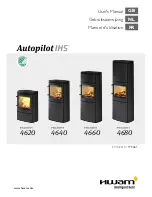
HearthStone Quality Home Heating Products Inc
®
Model 8390
15
There are basically two ways to install a
prefabricated metal chimney:
•
An
interior
installation where the chimney
passes inside the residence through the
ceiling and roof.
•
An e
xterior
installation where the chimney
passes through the wall behind the stove
then up the outside of the residence.
Chimney Cap
Extended Roof
Support Bracket
(Conduit
not included)
Storm Collar
Adjustable Roof
Flashing
Twist-Lock
Chimney Sections
Attic Insulation Shield
Firestop Radiation
Shield
Firesafe Enclosure
Two story house installation with attic.
Stovepipe
Support Box and Trim
Collar with built-in
Starter section
Chimney through outer wall with enclosed chase.
One story house installation with attic.
Chimnet Cap
Storm Collar
Flashing
Chimney Sections
Chase Enclosure
Wall Strap
Support Box
with built-in
Starter
Adjustable Roof
Tee
Wall Thimble
Tee clean-out
Access door
Tee Support Bracket
Chimney is supported by Tee Support Bracket.
Chimney is supported by Ceiling.
Chimnet Cap
Storm Collar
Flashing
Adjustable Roof
section
Insullation
Shield
Stovepipe
Chimney pipe through Clay tile
Chimnet Cap
Storm Collar
Flashing
Chimney Sections
Masonry Chimney
Adjustable Roof
Tee
Wall Thimble
Tee clean-out
Access door
or other Lined Masonry Chimney
Clay tile or
other Liner
Whenever possible, choose an interior chimney.
An interior chimney heats up more quickly and
retains its heat; thus promotes a better draft and
discourages the formation of creosote. An
exterior chimney does not benefit from the
warmth of being surrounded by the building, so
it typically operates at lower flue temperatures
than an interior chimney. An exterior
chimney’s draft is not as strong and may
experience increased creosote accumulation.
















































